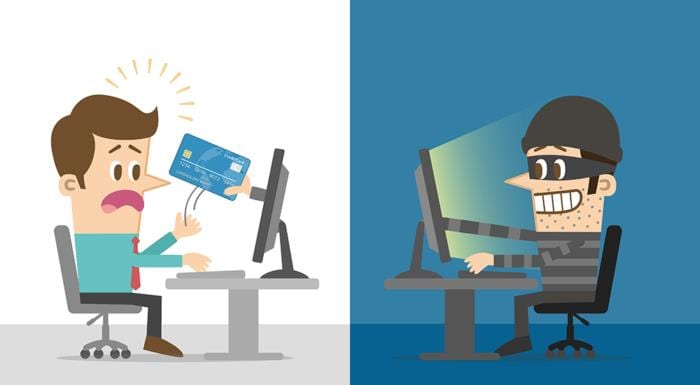Identity theft is one of the fastest-growing crimes in the United States today. According to the Identity Fraud Study, more than 14.4 million Americans were victims of fraud in 2019. Credit card fraud was the most prevalent in identity theft cases, and the victim’s out-of-pocket fraud losses totaled $1.7 billion. That is more than double than what was reported in 2016.
This type of fraud continues to pose challenges for consumers as cybercriminals develop new strategies and mechanisms to commit theft. They are becoming more adept at overriding stringent authentication processes, specifically targeting mobile phone takeovers. Let’s face it. Most of us have our most valuable personal information stored on our phones and online. This includes our full names, addresses, social security numbers, credit card numbers, passport numbers, and many more.
How Identity Theft Happens

Identity theft occurs when someone else steals your personal identifying information (PII) and pretends to be you with the purpose of committing fraud and gain financial benefits. Due to the nature of technology and the internet, it may be impossible to notice that you have been victimized until after the damage has been done. Here are some common ways thieves may access this information:
Phishing
Phishing is one of the most common methods that cybercriminals use to lure you into giving out your PII, banking details, and passwords. They use fraudulent emails or text messages that look like they were sent by a legitimate institution or company that you trust. Most of the messages contain a link that will be used to download malware into your device, mine for the needed information, and send these to a remote computer.
Skimming
Credit card skimming happens when the fraudsters use small, illegal devices or “skimmers” to steal credit card details from self-service machines. These devices fit on top of real card readers, and once a card is swiped through, the device captures and stores all the needed information from the card’s magnetic stripe. Victims are most often than not completely blindsided and will only know once they see the fraudulent transactions on their credit card bills.
Data Breaches
A data breach happens when hackers gain access to an organization’s data without authorization and expose confidential or protected information. One of the biggest data breaches to happen was the 2017 Equifax data breach, where up to 147 million people’s data were exposed. The breach primarily exposed the victims’ full names, birth dates, and social security numbers, which is enough information for criminals to commit identity theft.
Wi-Fi Hacking
Browsing the internet is safe if you stick to encrypted wi-fi connections. Unfortunately, some public connections are not, allowing criminals to snoop on information traveling to and from your device. Identity thieves may also create fake Wi-Fi hotspots in order to commit their fraud.
Dumpster Diving
While it may be tempting to just toss paper documents that may or may not contain personal information into the nearest dumpster, proper disposal is important if you want to avoid becoming a victim of identity theft. Aside from credit card bills, such documents include receipts, checks, and pre-approved credit card offers. Even throwing away documents that contain only your name and address is more than enough for thieves to steal your identity.
How to Tell if You Are A Victim of Identity Theft

Many identity thieves are very clever, and their methods can be extremely calculated. It is extremely frustrating to discover that you have been a victim of identity theft for a long time without even noticing it. It can take many long months of filling out forms and working with different organizations just to recover your identity. Thus, it pays to educate yourself on how to tell if someone has stolen your information. Here are some signs that things are amiss:
Discrepancies in your financial statements and credit reports
It pays to monitor your bank statements and credit reports frequently. Read your bills and keep an eye on purchases and withdrawals that you did not make. For your credit report, you can view a summary of your reports regularly through various monitoring services. Watch out for an inexplicable drop in your reports as this could be a dead giveaway that someone had damaged your credit.
Mails and bills are not reaching you
Did you stop getting important mails such as bank and credit card statements? This could mean that someone has been combing through and stealing your mails to find personal information. Thieves have also been known to fill out change of address forms to intercept your emails and access your details.
Health insurance concerns
Another sign of identity theft is when you receive medical bills or even an explanation of health care services that you did not request.
How to Report Identity Theft

Now that we know the common methods thieves use to steal our identities, it is important to limit the potential damage even if you have an inkling that you’ve fallen victim to any of these mechanisms.
To report identity theft, the best way is to contact the Federal Trade Commission (FTC) online at IdentityTheft.gov. Once reported, they will provide you with a personalized recovery plan, guidance, reports to track the progress, and pre-filled letters to send to the different financial creditors.
Reach out to your banks double-check your credit reports, and contact at least one of the three major credit bureaus (TransUnion, Equifax, and Experian). If something is amiss, you might want to consider freezing your credit.
Next, report your case to the police if a creditor or other affected parties insist you produce a police report. If you also know the identity of the thief and have other information to aid law enforcement in bringing the criminals to justice, it is crucial to report this immediately. Cybercriminals continue to diversify their targets and use stealthier methods to commit identity theft. In fact, according to FTC, identity theft is now the top reason for consumer complaints. Thus, the importance of being vigilant and the need to constantly monitoring our accounts and credit reports avoiding this harrowing experience. If identity theft happens, report this to the appropriate agencies immediately.



